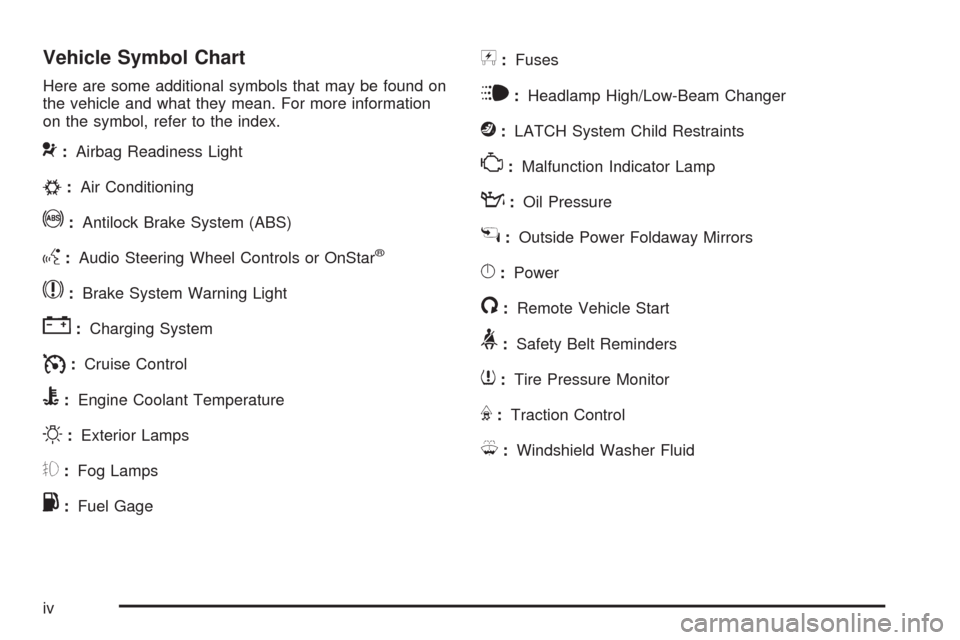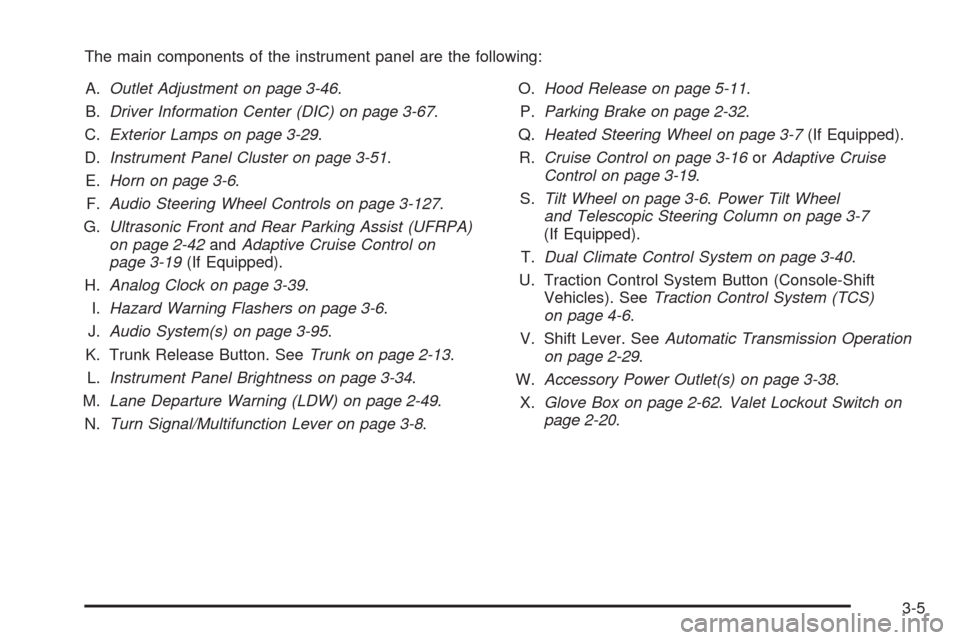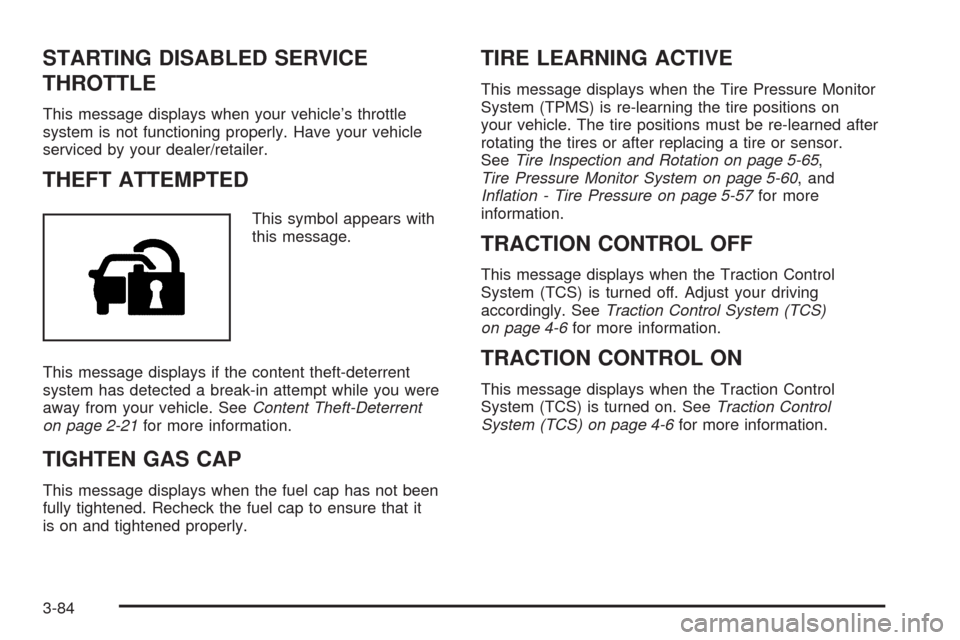traction control CADILLAC DTS 2009 1.G Owners Manual
[x] Cancel search | Manufacturer: CADILLAC, Model Year: 2009, Model line: DTS, Model: CADILLAC DTS 2009 1.GPages: 462, PDF Size: 2.46 MB
Page 4 of 462

Vehicle Symbol Chart
Here are some additional symbols that may be found on
the vehicle and what they mean. For more information
on the symbol, refer to the index.
9:Airbag Readiness Light
#:Air Conditioning
!:Antilock Brake System (ABS)
g:Audio Steering Wheel Controls or OnStar®
$:Brake System Warning Light
":Charging System
I:Cruise Control
B:Engine Coolant Temperature
O:Exterior Lamps
#:Fog Lamps
.:Fuel Gage
+:Fuses
i:Headlamp High/Low-Beam Changer
j:LATCH System Child Restraints
*:Malfunction Indicator Lamp
::Oil Pressure
g:Outside Power Foldaway Mirrors
}:Power
/:Remote Vehicle Start
>:Safety Belt Reminders
7:Tire Pressure Monitor
F:Traction Control
M:Windshield Washer Fluid
iv
Page 142 of 462

Brake System Warning Light..........................3-56
Antilock Brake System (ABS) Warning Light.....3-57
Traction Control System (TCS) Warning Light . . .3-58
StabiliTrak
®Indicator Light.............................3-58
Lane Departure Warning (LDW) Light..............3-59
Engine Coolant Temperature Warning Light......3-59
Engine Coolant Temperature Gage..................3-60
Tire Pressure Light.......................................3-60
Malfunction Indicator Lamp.............................3-61
Oil Pressure Light.........................................3-64
Security Light...............................................3-65
Fog Lamp Light............................................3-65
Lights On Reminder......................................3-65
Cruise Control Light......................................3-66
Highbeam On Light.......................................3-66
Fuel Gage...................................................3-66Driver Information Center (DIC).......................3-67
DIC Operation and Displays...........................3-68
DIC Warnings and Messages.........................3-73
DIC Vehicle Customization.............................3-86
Audio System(s).............................................3-95
Setting the Clock..........................................3-96
Radio(s) (MP3).............................................3-99
Using an MP3............................................3-110
XM Radio Messages...................................3-115
Navigation/Radio System..............................3-116
Bluetooth
®.................................................3-116
Theft-Deterrent Feature................................3-127
Audio Steering Wheel Controls......................3-127
Radio Reception.........................................3-128
Backglass Antenna......................................3-129
XM™ Satellite Radio Antenna System............3-129
Section 3 Instrument Panel
3-2
Page 145 of 462

The main components of the instrument panel are the following:
A.Outlet Adjustment on page 3-46.
B.Driver Information Center (DIC) on page 3-67.
C.Exterior Lamps on page 3-29.
D.Instrument Panel Cluster on page 3-51.
E.Horn on page 3-6.
F.Audio Steering Wheel Controls on page 3-127.
G.Ultrasonic Front and Rear Parking Assist (UFRPA)
on page 2-42andAdaptive Cruise Control on
page 3-19(If Equipped).
H.Analog Clock on page 3-39.
I.Hazard Warning Flashers on page 3-6.
J.Audio System(s) on page 3-95.
K. Trunk Release Button. SeeTrunk on page 2-13.
L.Instrument Panel Brightness on page 3-34.
M.Lane Departure Warning (LDW) on page 2-49.
N.Turn Signal/Multifunction Lever on page 3-8.O.Hood Release on page 5-11.
P.Parking Brake on page 2-32.
Q.Heated Steering Wheel on page 3-7(If Equipped).
R.Cruise Control on page 3-16orAdaptive Cruise
Control on page 3-19.
S.Tilt Wheel on page 3-6.Power Tilt Wheel
and Telescopic Steering Column on page 3-7
(If Equipped).
T.Dual Climate Control System on page 3-40.
U. Traction Control System Button (Console-Shift
Vehicles). SeeTraction Control System (TCS)
on page 4-6.
V. Shift Lever. SeeAutomatic Transmission Operation
on page 2-29.
W.Accessory Power Outlet(s) on page 3-38.
X.Glove Box on page 2-62.Valet Lockout Switch on
page 2-20.
3-5
Page 156 of 462

Cruise Control
With cruise control, a speed of approximately 25 mph
(40 km/h) or more can be maintained without keeping
your foot on the accelerator. Cruise control does not work
at speeds below about 25 mph (40 km/h). A cruise control
light appears in the instrument panel cluster when the
cruise control is on.
When the brakes are applied, the cruise control
shuts off.{CAUTION:
Cruise control can be dangerous where you
cannot drive safely at a steady speed. So, do
not use the cruise control on winding roads or
in heavy traffic.
Cruise control can be dangerous on slippery roads.
On such roads, fast changes in tire traction can
cause excessive wheel slip, and you could lose
control. Do not use cruise control on slippery roads.
If your vehicle is in cruise control when the Traction
Control System (TCS) begins to limit wheel spin, the
cruise control automatically turns off. SeeTraction
Control System (TCS) on page 4-6. When road
conditions let you safely use it again, the cruise
control can be turned back on.
3-16
Page 160 of 462

ACC uses radar to detect a vehicle directly ahead
in your path, within a distance of 330 ft (100 m), and
operates at speeds above 25 mph (40 km/h). When it
is engaged by the driver, the system can apply limited
braking or acceleration of the vehicle automatically
to maintain a selected follow distance to the vehicle
ahead. Braking is limited to 0.25 g’s (2.45 m/sec2)
of deceleration, which is comparable to moderate
application of the vehicle’s brakes. To disengage ACC,
apply the brake. If no vehicle is in your path, the vehicle
will react like traditional cruise control.
{CAUTION:
Adaptive Cruise Control will not apply hard braking
or bring the vehicle to a complete stop. It will not
respond to stopped vehicles, pedestrians or
animals. When you are approaching a vehicle or
object, Adaptive Cruise Control may not have time
to slow your vehicle enough to avoid a collision.
Your complete attention is always required while
driving and you should be ready to take action
and apply the brakes. For more information,
seeDefensive Driving on page 4-2.
{CAUTION:
On winding roads, Adaptive Cruise Control
may not detect a vehicle ahead. You could
crash into a vehicle ahead of you. Do not use
Adaptive Cruise Control on winding roads.
Adaptive Cruise Control may not have time
to slow your vehicle enough to avoid a crash
when you are driving in conditions where
vehicles may suddenly slow or stop ahead of
you, enter your lane, or cross your vehicle’s
path. If you are driving in these conditions, do
not use Adaptive Cruise Control. The warning
beep and alert symbol may indicate that you
are driving in conditions where Adaptive Cruise
Control should not be used. See “Alerting the
Driver” in this section.
On slippery roads, fast changes in tire traction
can cause needless wheel spinning, and you
could lose control. Do not use cruise control on
slippery roads.
CAUTION: (Continued)
3-20
Page 162 of 462

Engaging ACC With the Set Button
{CAUTION:
If you leave your Adaptive Cruise Control switch
on when you are not using cruise, you might hit a
button and go into cruise when you do not want
to. You could be startled and even lose control.
Keep the Adaptive Cruise Control switch off until
you want to use cruise control.
The set speed is selected by the driver. This is the
speed your vehicle will travel if there is no vehicle
detected in its path.
To set ACC, do the following:
1. Press the
]button.
2. Get up to the speed desired.
3. Press in the SET– button and release it.
4. Take your foot off the accelerator pedal.
Once ACC is set, it may immediately apply the brakes if
it detects a vehicle ahead is too close or moving slower
than your vehicle.The on symbol is located on the display at the top of the
instrument panel to the right of the driver. When the on
symbol is lit on the display, it indicates that ACC is active.
A message on the DIC will also display when ACC is
set. SeeDIC Warnings and Messages on page 3-73.
Keep in mind speed limits, surrounding traffic speeds,
and weather conditions when adjusting your set speed.
If the vehicle is in ACC when the traction control system
begins to limit wheel spin, the ACC will automatically
disengage. SeeTraction Control System (TCS) on
page 4-6andStabiliTrak
®System on page 4-6. When
road conditions allow you to safely use it again, the ACC
can be turned back on.
Increasing Set Speed While Using ACC
There are two ways to increase the set speed:
Use the accelerator to get to the higher speed.
Press the SET– button and then release the
button and the accelerator pedal. The vehicle
will now cruise at the higher speed.
Press the +RES button. Hold it there until the
desired set speed is displayed on the Driver
Information Center (DIC), then release the switch.
To increase the set speed in very small amounts,
move the switch brie�y to +RES. Each time this is
done, the set speed increases by 1 mph (1 km/h).
3-22
Page 198 of 462

Traction Control System (TCS)
Warning Light
This warning light comes
on brie�y while starting the
engine.
If it does not, have the vehicle serviced by your
dealer/retailer. If the system is working normally the
indicator light will then go off.
If it stays on, or comes on while driving, there may
be a problem with the traction control system and the
vehicle needs service. When this warning light is on,
the system will not limit wheel spin.
If the traction control system warning light comes on
and stays on when the system is turned on, the vehicle
needs service. SeeTraction Control System (TCS)
on page 4-6for more information.
StabiliTrak®Indicator Light
For vehicles with the
StabiliTrak®system, this
light comes on brie�y while
starting the engine.
If it does not, have the vehicle serviced by your
dealer/retailer. If the system is working normally the
indicator light then goes off.
If the light comes on and stays on while driving, there
could be a problem with the StabiliTrak
®system and the
vehicle might need service. When this warning light is
on, the StabiliTrak
®system is off and does not limit
wheel spin.
The light �ashes if the system is active and is working
to assist the driver with directional control of the
vehicle in difficult driving conditions.
SeeStabiliTrak
®System on page 4-6for more
information.
3-58
Page 222 of 462

SERVICE SUSPENSION SYS (System)
This message displays when the magnetic ride
control or automatic leveling control system is not
operating properly. Have your vehicle serviced by
your dealer/retailer.
SERVICE THEFT DETERRENT SYSTEM
This message displays when there is a problem with
the theft-deterrent system programmed in the key. A fault
has been detected in the system which means that the
system is disabled and it is not protecting the vehicle.
The vehicle usually restarts; however, you may want to
take the vehicle to your dealer/retailer before turning off
the engine. SeePASS-Key
®III+ Electronic Immobilizer
Operation on page 2-23for more information.
SERVICE TIRE MONITOR SYSTEM
On vehicles with the Tire Pressure Monitor System
(TPMS), this message displays if a part on the TPMS
is not working properly. The tire pressure light
also �ashes and then remains on during the same
ignition cycle. SeeTire Pressure Light on page 3-60.
Several conditions may cause this message to appear.
SeeTire Pressure Monitor Operation on page 5-61for
more information. If the warning comes on and stays
on, there may be a problem with the TPMS, see your
dealer/retailer.
SERVICE TRACTION CONTROL
This message displays when there is a problem with the
Traction Control System (TCS). When this message is
displayed, the system will not limit wheel spin. Adjust your
driving accordingly. See your dealer/retailer for service.
SeeTraction Control System (TCS) on page 4-6for more
information.
SERVICE TRANSMISSION
This message displays when there is a problem with the
vehicle’s transmission. Have your vehicle serviced by
your dealer/retailer.
SERVICE VEHICLE SOON
This message displays when a non-emissions related
malfunction occurs. Have your vehicle serviced by your
dealer/retailer as soon as possible.
SET SPD (Speed)
If your vehicle has Adaptive Cruise Control (ACC),
this message displays whenever the cruise control is
set. First, the “CRUISE SET TO XXX MPH (km/h)”
message appears. After a few seconds, the “CRUISE
SET TO XXX MPH (km/h)” message clears and the
message “SET SPD XX” displays at the bottom of the
DIC. See “CRUISE SET TO XXX MPH (km/h)” earlier in
this section andAdaptive Cruise Control on page 3-19
for more information.
3-82
Page 223 of 462

SIDE BLIND ZONE ALERT
SYSTEM OFF
If your vehicle has the Side Blind Zone Alert (SBZA)
system, this message displays when the SBZA system
has been turned off. SeeSide Blind Zone Alert (SBZA) on
page 2-45andDIC Operation and Displays on page 3-68
for more information.
SIDE BLIND ZONE SYSTEM
UNAVAILABLE
If your vehicle has the Side Blind Zone Alert (SBZA)
system, this message displays when the SBZA system is
disabled because the sensor is blocked and cannot
detect vehicles in your blind zone. The sensor may be
blocked by mud, dirt, snow, ice, or slush. This message
may also display during heavy rain or due to road spray.
It may also come on when driving in isolated areas with
no guardrails, trees, or road signs and light traffic. Your
vehicle does not need service. For cleaning instructions,
seeWashing Your Vehicle on page 5-90. SeeSide Blind
Zone Alert (SBZA) on page 2-45for more information.
SPEED LIMIT XXX MPH (km/h)
This message displays when the Speed Alert has been
turned on through the DIC Information Menu and the
vehicle is at or above the speed limit. SeeDIC Operation
and Displays on page 3-68for more information.
SPEED LIMITED TO XXX MPH (km/h)
This message displays when your vehicle speed
is limited to 80 mph (128 km/h) because the vehicle
detects a problem in the speed variable assist steering,
magnetic ride control, or automatic leveling control
systems. Have your vehicle serviced by your
dealer/retailer.
STABILITRAK NOT READY
If your vehicle has StabiliTrak, this message may
display and the Traction Control System and StabiliTrak
Warning Light on the instrument panel cluster may
be on after �rst driving the vehicle and exceeding
19 mph (30 km/h) for 30 seconds. The StabiliTrak
system is not functional until the light has turned off.
SeeStabiliTrak
®System on page 4-6for more
information.
3-83
Page 224 of 462

STARTING DISABLED SERVICE
THROTTLE
This message displays when your vehicle’s throttle
system is not functioning properly. Have your vehicle
serviced by your dealer/retailer.
THEFT ATTEMPTED
This symbol appears with
this message.
This message displays if the content theft-deterrent
system has detected a break-in attempt while you were
away from your vehicle. SeeContent Theft-Deterrent
on page 2-21for more information.
TIGHTEN GAS CAP
This message displays when the fuel cap has not been
fully tightened. Recheck the fuel cap to ensure that it
is on and tightened properly.
TIRE LEARNING ACTIVE
This message displays when the Tire Pressure Monitor
System (TPMS) is re-learning the tire positions on
your vehicle. The tire positions must be re-learned after
rotating the tires or after replacing a tire or sensor.
SeeTire Inspection and Rotation on page 5-65,
Tire Pressure Monitor System on page 5-60, and
Inflation - Tire Pressure on page 5-57for more
information.
TRACTION CONTROL OFF
This message displays when the Traction Control
System (TCS) is turned off. Adjust your driving
accordingly. SeeTraction Control System (TCS)
on page 4-6for more information.
TRACTION CONTROL ON
This message displays when the Traction Control
System (TCS) is turned on. SeeTraction Control
System (TCS) on page 4-6for more information.
3-84